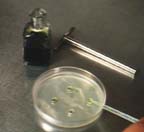|


|
Materials
Cultures of indicator
organism(s). (These are bacteria or fungi that will be inhibited by the
test chemical.)
Leaves or other
plant parts to test
Mortar and pestle
Solvent
Pasteur pipettes
(2)
Nutrient agar
plate (One for each indicator organism)
Cork borer (4-mm
diameter)
Sterile
cotton swab
Procedures
- Prepare plant tissue
extracts by grinding the appropriate tissue in a few milliliters of
solvent in a mortar and pestle. Possible solvents are sterile water;
methyl alcohol, ethyl alcohol, or acetone.
- Sterilize a cork
borer by autoclaving or disinfect it by rising in alcohol followed by
sterile water. Obtain a nutrient agar plate and aseptically punch (4-mm)
holes in the agar using a cork borer. Using a wax pencil, mark the underside
of the Petri to label the wells.
- Aseptically swab
the indicator organism onto a nutrient agar plate. Swab in three directions
to ensure complete plate coverage. Let the plate stand for 5 minutes..
- Place 1, 2, or
3 drops of the filtered plant extract in the appropriate wells.
- Fill one well with
the solvent used to prepare the tissue extracts. This is a control.
- Incubate the plate
at 35°C for 24 to 48 hrs. Measure the zones of inhibition in millimeters,
using a ruler on the underside of the plate. Record the zone size.
- Discard all cultures
in the "To be autoclaved" area.
|
![]() AgarDiffusion
Assay
AgarDiffusion
Assay![]() Well
Diffusion Assay
Well
Diffusion Assay![]() MIC
Determination
MIC
Determination![]() Developing
Resistance
Developing
Resistance![]() Soil
Screening
Soil
Screening![]() Isolating
Active Compounds
Isolating
Active Compounds
